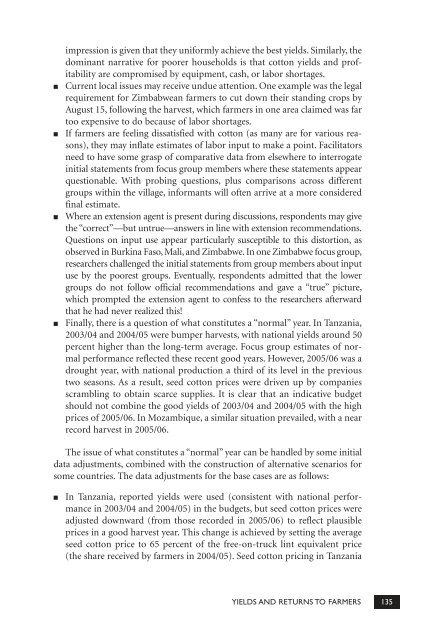Organization and Performance of Cotton Sectors in Africa ... - infoDev
Organization and Performance of Cotton Sectors in Africa ... - infoDev
Organization and Performance of Cotton Sectors in Africa ... - infoDev
You also want an ePaper? Increase the reach of your titles
YUMPU automatically turns print PDFs into web optimized ePapers that Google loves.
■■■■impression is given that they uniformly achieve the best yields. Similarly, thedom<strong>in</strong>ant narrative for poorer households is that cotton yields <strong>and</strong> pr<strong>of</strong>itabilityare compromised by equipment, cash, or labor shortages.Current local issues may receive undue attention. One example was the legalrequirement for Zimbabwean farmers to cut down their st<strong>and</strong><strong>in</strong>g crops byAugust 15, follow<strong>in</strong>g the harvest, which farmers <strong>in</strong> one area claimed was fartoo expensive to do because <strong>of</strong> labor shortages.If farmers are feel<strong>in</strong>g dissatisfied with cotton (as many are for various reasons),they may <strong>in</strong>flate estimates <strong>of</strong> labor <strong>in</strong>put to make a po<strong>in</strong>t. Facilitatorsneed to have some grasp <strong>of</strong> comparative data from elsewhere to <strong>in</strong>terrogate<strong>in</strong>itial statements from focus group members where these statements appearquestionable. With prob<strong>in</strong>g questions, plus comparisons across differentgroups with<strong>in</strong> the village, <strong>in</strong>formants will <strong>of</strong>ten arrive at a more consideredf<strong>in</strong>al estimate.Where an extension agent is present dur<strong>in</strong>g discussions, respondents may givethe “correct”—but untrue—answers <strong>in</strong> l<strong>in</strong>e with extension recommendations.Questions on <strong>in</strong>put use appear particularly susceptible to this distortion, asobserved <strong>in</strong> Burk<strong>in</strong>a Faso, Mali, <strong>and</strong> Zimbabwe. In one Zimbabwe focus group,researchers challenged the <strong>in</strong>itial statements from group members about <strong>in</strong>putuse by the poorest groups. Eventually, respondents admitted that the lowergroups do not follow <strong>of</strong>ficial recommendations <strong>and</strong> gave a “true” picture,which prompted the extension agent to confess to the researchers afterwardthat he had never realized this!F<strong>in</strong>ally, there is a question <strong>of</strong> what constitutes a “normal” year. In Tanzania,2003/04 <strong>and</strong> 2004/05 were bumper harvests, with national yields around 50percent higher than the long-term average. Focus group estimates <strong>of</strong> normalperformance reflected these recent good years. However, 2005/06 was adrought year, with national production a third <strong>of</strong> its level <strong>in</strong> the previoustwo seasons. As a result, seed cotton prices were driven up by companiesscrambl<strong>in</strong>g to obta<strong>in</strong> scarce supplies. It is clear that an <strong>in</strong>dicative budgetshould not comb<strong>in</strong>e the good yields <strong>of</strong> 2003/04 <strong>and</strong> 2004/05 with the highprices <strong>of</strong> 2005/06. In Mozambique, a similar situation prevailed, with a nearrecord harvest <strong>in</strong> 2005/06.The issue <strong>of</strong> what constitutes a “normal” year can be h<strong>and</strong>led by some <strong>in</strong>itialdata adjustments, comb<strong>in</strong>ed with the construction <strong>of</strong> alternative scenarios forsome countries. The data adjustments for the base cases are as follows:■In Tanzania, reported yields were used (consistent with national performance<strong>in</strong> 2003/04 <strong>and</strong> 2004/05) <strong>in</strong> the budgets, but seed cotton prices wereadjusted downward (from those recorded <strong>in</strong> 2005/06) to reflect plausibleprices <strong>in</strong> a good harvest year. This change is achieved by sett<strong>in</strong>g the averageseed cotton price to 65 percent <strong>of</strong> the free-on-truck l<strong>in</strong>t equivalent price(the share received by farmers <strong>in</strong> 2004/05). Seed cotton pric<strong>in</strong>g <strong>in</strong> TanzaniaYIELDS AND RETURNS TO FARMERS 135
















